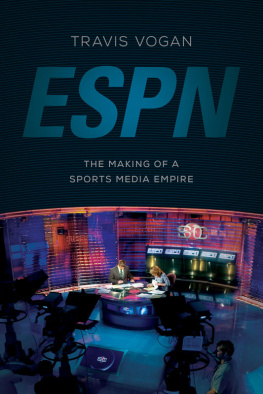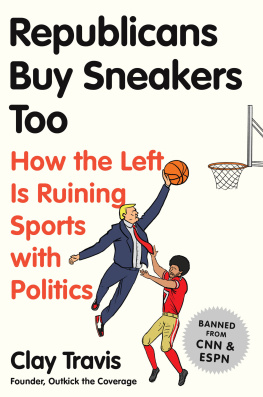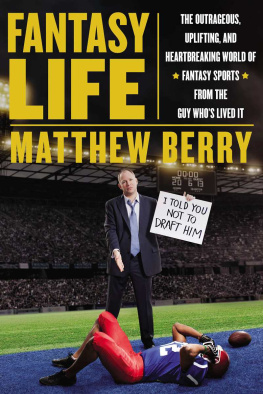ESPN
The Making of a Sports Media Empire
ESPN
The Making of a Sports Media Empire
TRAVIS VOGAN
UNIVERSITY OF ILLINOIS PRESS
Urbana, Chicago, and Springfield
2015 by the Board of Trustees
of the University of Illinois
All rights reserved
Manufactured in the United States of America
1 2 3 4 5 C P 5 4 3 2 1
 This book is printed on acid-free paper.
This book is printed on acid-free paper.
Library of Congress Cataloging-in-Publication Data
Vogan, Travis.
ESPN : the making of a sports media empire / Travis Vogan.
pages cm
Includes bibliographical references and index.
ISBN 978-0-252-03976-8 (hardcover : alk. paper)
ISBN 978-0-252-08122-4 (pbk. : alk. paper)
ISBN 978-0-252-09786-7 (e-book)
1. ESPN (Television network)History. 2. Television broadcasting of sportsHistory. I. Title.
gv742.3.v62 2015
070.4'49796dc23 2015012600
Contents
Acknowledgments
This book includes a lot of voices. These voices, I think, offer a sense of vitality and even humanity to what is, in the end, a relatively straightforward cultural and industrial analysis. In fact, this books best and most interesting moments come not from me, but from the many sports media professionals who took the time to teach me about ESPN, the circumstances out of which it emerged, the principles that guide it, and the ever-bulging industry it now so self-assuredly purports to lead. The people with whom I spokeand who facilitated my correspondencesinclude Jim Allegro, Michael Antinoro, Jim Bates, Brian Bedol, Bob Beyus, Steve Bornstein, Tommy Craggs, John Dahl, Amanda DeCastro, Mark Durand, Stuart Evey, Steve Fainaru, Mark Fainaru-Wada, Nathaniel Friedman, Libby Geist, Laura Gentile, Jonathan Hock, Steve Isenberg, Nick Kastner, Peter King, Josh Krulewitz, John Lack, Chris LaPlaca, Will Leitch, Shari Leventhal, Robert Lipsyte, Tina Pagano, Bill Rasmussen, Don Rasmussen, Scott Rasmussen, Steve Rotfeld, David Roth, Erik Rydholm, Connor Schell, Ron Semiao, Mark Shapiro, Dan Silver, John Skipper, Alfred Slote, Erik Smetana, Glenn Stout, John Walsh, Jess Walter, Royce Webb, Ron Wechsler, and Norby Williamson. Others opted to remain anonymous (though I did not include any quotations from off the record sources in the manuscript). Thanks to all who agreed to be interviewedyour memories, perspectives, and observations improved this book immeasurably.
Big thanks to Mo Smith for making some introductions that got the ball rolling on my interviewsand wound up convincing me to take my research for this that helped me to work through a handful of ideas that are sprinkled about this manuscript. It is an honor to have the fingerprints of so many scholars whom I admire on the finished product.
I had the great fortune of research assistance from a bright cast of now former University of Iowa undergraduates: Tom Clos, Bria Davis, Mallory Miranda, and Brady Starnes. Thanks also to the good people at Columbia Universitys Rare Book & Manuscript Library for facilitating my research trip to peruse Roone Arledges papers. My research assistance and trips were funded in part by much-appreciated start-up funds and an Old Gold Summer Fellowship from the University of Iowa College of Arts & Sciences. The University of Iowa School of Journalism & Mass Communications Becky Kick and the Department of American Studies Laura Kastens were commendably patient in helping me to organize and pay for these ventures.
Thanks are due to several journals Convergence: The International Journal for Research into New Media Technologies , the International Journal of Sport Communication , and the Journal of Sport History that granted me the privilege of piloting some ideas that show up in this book in dramatically revised and expanded form.
It is a unique luxury to be able to spend ones professional life doing something enjoyable. It is even sweeter when that life is filled with enjoyable people. I am so fortunate to be surrounded by good-humored colleagues here in the University of Iowas School of Journalism & Mass Communication and Department of American Studies.
As with all big tasks, it helps to be in the company of clever, experienced, and easygoing folks. I had such a positive experience working with the University of Illinois Pressand Danny Nasset in particularfor my first book that I decided to give it another go with them. Danny, Bill Regier, Tad Ringo, Steve Fast, Kevin Cunningham, and the rest of the crew at UIP have made the laborious process of transforming an idea into a book seem relatively smooth. Thanks also to Annette Wenda for the copyediting services and to Kristen Fuhs for putting the index together.
Finallyand most importantthanks go out to my friends and family for dealing with me all these years.
ESPN
The Making of a Sports Media Empire
INTRODUCTION
An ESPN Culture
We believe that the appetite for sports in this country is insatiable.
Bill Rasmussen, ESPN cofounder
ESPN has turned sports into a utility. What ESPN did was to make it possible to turn on your TV and have sports come out, just like turning on your faucet and have water come out.
Robert Thompson, Syracuse University Center for the Study of Popular Television
Shortly after ESPNs September 7, 1979, launch, the Washington Post s Jane Leavy asked the new outlets president, Chet Simmons, how he thought the public would respond to an all-sports cable TV network. I guess well have to have a battery of divorce lawyers standing by to handle all the cases, Simmons quipped. Did you ever think that a television network would be named as a corespondent in a divorce action?
In 1998 ESPN set up a satellite receiver in Antarctica for eight total viewers. The move transformed it into the only cable outlet that provides service to every continent on Earth. In the process, it made the networks self-given title as The Worldwide Leader in Sports (also adopted in 1998) seem slightly less audacious. As then ESPN chair Steve Bornstein remarked, The sun never sets on the ESPN empire.
On January 26, 2000, Alisha and Chad Blondeel of Newaygo, Michigan, named their newborn son Espena tribute to Chads favorite TV channel. Though the first, Espen Blondeel was not the last of ESPNs honorary progeny. As part of its twenty-fifth anniversary celebration in 2004, ESPN included a segment that featured eleven young Espens (several of which spelled the name Espn). The name is now registered on Babynames.com . As silly as it may be to name a child Espn, it is almost unimaginable that an infant would be christened HGTV, VH1, or Comedy Central. This is because these parents named their children not after a cable network, but after a brand, a set of cultural meanings that exceed the institution they represent and serve as a recognizable marker of identity and community.
In 2006 ESPN unveiled Mobile ESPN, a cellular phone that also provided on-demand sports content anywhere its customers roamed.
What could be more popular than ESPN? Not much, according to two 2014 Forbes reports that named it the worlds most valuable media property and the second most valuable sports brand after Nike. with spouses, kids, and jobs) rather than a site that provokes thought. Sports media have a reputation for not providing much in the way of credibility, complexity, or edification. Those who consume sports media have a reputation for not demanding these qualities.
If culture, notes sports media scholar David Rowe, is the stuff of everyday lifethe frame through which we experience, interpret, mold, and represent everything that surrounds usthen sport occupies an uncommonly prominent position within it. By extension, if media, as Robert W. McChesney claims, made sport, then sports media play a key role in culture. The aesthetic, economic, industrial, and political contexts that inform sports and mass medias long-standing symbiosis shape sports cultural meanings and uses. No institution has, or has ever had, a more influential role in this popular milieu than ESPN. We blame our failed relationships on it, name our children after it, and can access it anytime and anywhereeven in Antarctica. If you go to an ESPN Zone restaurant and order enough ESPYsa cocktail named after ESPNs annual awards showyou can get drunk on ESPN. In short, we live in an ESPN culture.








 This book is printed on acid-free paper.
This book is printed on acid-free paper.